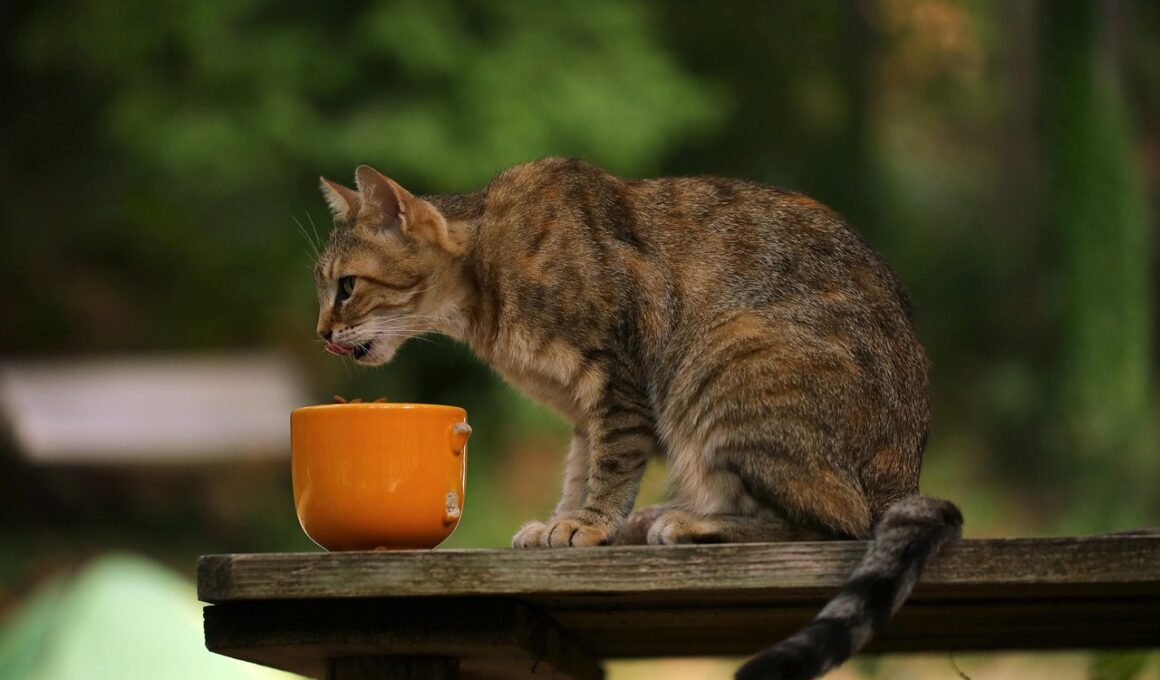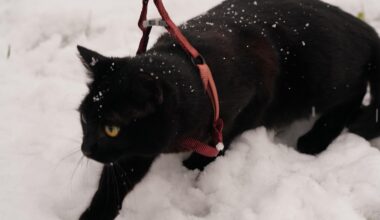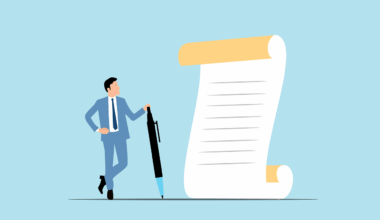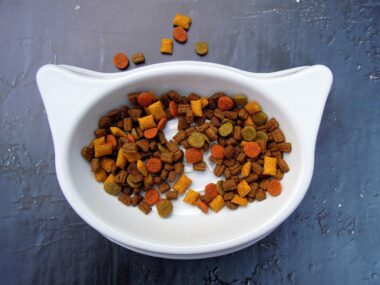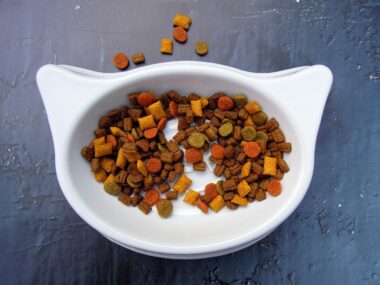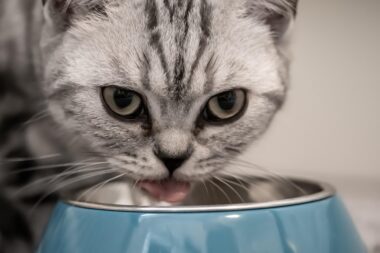How to Prevent Food Spillage with the Right Feeding Accessories
Choosing the right food bowls and feeding tools is crucial for reducing food spillage during mealtime. Cats can be quite messy, and their eating habits contribute to this issue. You can minimize this mess by selecting bowls designed specifically for cats’ unique behaviors and preferences. It’s essential to look for non-slip bases, which can prevent bowls from sliding during enthusiastic meals. Additionally, consider the material of the bowl; stainless steel or ceramic options are often preferred since they are sturdy and easier to clean. Also, the size of the bowl should be proportionate to your cat’s size. Bowls that are too small may cause a mess, while those that are excessively large may lead to overfeeding. For those cats that prefer to munch without the discomfort of their whiskers touching the sides, look for wider pans. Furthermore, investing in interactive feeding tools might engage your pet and slow down their eating speed, ultimately resulting in less spillage. To wrap up, making informed choices in bowls and tools can create a cleaner mealtime for your feline friend.
When selecting feeding accessories, it’s also important to take into consideration the depth and height of the food bowls. Cats have unique preferences for how deep their food should be, and a bowl that is too deep may discourage them from eating properly. Shallow bowls can help them access their food without discomfort, reducing the chances of spilling. Also, elevation is another factor; elevated bowls can be a great solution for older cats or those with joint issues. Maintaining an elevated position can ease feeding and encourage better posture during mealtime. It’s advisable to observe your cat’s eating habits and preferences before finalizing your choice of feeding tools. Furthermore, select bowls with a stable base; materials such as rubber or weighted bases can prevent slipping. Hygiene is another critical aspect; ensure that your feeding accessories are dishwasher safe, as clean bowls contribute to your cat’s overall health. Frequent cleaning also discourages the growth of harmful bacteria. Lastly, don’t forget to replace worn-out bowls. Regularly updating feeding accessories is essential as worn materials can also lead to spills.
Choosing Interactive Feeding Tools
Interactive feeding tools can greatly enhance your cat’s mealtime experience. These products are designed to challenge your cat mentally and physically, reducing the likelihood of food spillage while providing stimulation. For instance, puzzle feeders can slow down fast eaters, encouraging them to engage with their food. As your cat interacts with these tools, they learn to be more deliberate in their eating habits. As a result, you minimize food that falls outside of the bowl. You can also consider automatic feeders that dispense food at set intervals; this can help regulate your cat’s portions and reduce their tendency to overeat, which often leads to a mess. Look for options that have an infrared sensor to ensure only your cat accesses the food. Moreover, durable materials are key; ensure that the interactive feeders are made from quality materials that can withstand your cat’s enthusiasm. Personalize your interactive feeding experience based on your cat’s habits and preferences. Finally, interactive tools can exceed expectations by facilitating a fun and cleaner feeding time for both you and your beloved pet.
Another significant factor involves the type of food you serve your cat. Wet food tends to create messier situations than dry food, which might lead to more spills. Consider your cat’s feeding preferences and the integrity of your feeding environment when deciding. If you prefer feeding wet food, you might want to invest in bowls designed specifically for that consistency. These often have higher sides to reduce splatter and better contain the food while allowing your cat to enjoy their meal comfortably. Moreover, introducing a feeding mat can be a practical solution when using wetter food types. These mats can help collect any stray bits or spills that occur, safeguarding your floor from damage. They are easily removable and washable, adding extra convenience to your feeding routine. In addition, when choosing the type of food bowl, reflect on the visual aspects as well. A visually appealing bowl that matches your decor can enhance your space while serving your pet’s needs. So, weighing these options allows you to create a functional and aesthetically pleasing feeding. An efficient feeding setup leads to a cleaner environment.
Implementing a Consistent Feeding Schedule
Implementing a consistent feeding schedule is fundamental for promoting cleanliness during your cat’s mealtime. By feeding your cat at specific times each day, you can prepare the space and anticipate messes related to feeding. Cats thrive on routine, and consistent feeding can lead to positive behavioral changes. You can effectively manage the quantity and type of food provided at each meal, allowing you to monitor how much your cat eats and how often they spill. Moreover, feeding on a set schedule reduces the possibility of leaving food out longer than necessary. Cats are naturally inclined to nibble or snack throughout the day if food is left available for an extended period. Regularly scheduled meals help to minimize food waste and exceed expected cleanliness in your home. For this reason, always monitor the condition of the remaining food after each meal. If too much is left behind, or if spillage occurs frequently, adjust the portion sizes accordingly. Remember that every cat is unique; the frequency of feedings must suit their specific needs while maintaining cleanliness.
Another crucial aspect is incorporating a designated feeding area. Creating a specific space for your cat’s feeding accessories can greatly aid in reducing mess. Selecting a spot that is easy to clean, away from high traffic areas, limits the chances of accidental spills. Furthermore, placing food bowls on a non-porous surface makes cleaning much easier. A feeding station that includes a mat or tray not only contains spills but also collects crumbs that would typically end up on the floor. Additionally, using bowls with high-sided walls helps contain the food while allowing your cat to eat comfortably. If you introduce multiple cats to the mix, consider providing separate feeding stations to minimize competition, leading to less raucous eating and resultant spills. Supplementing your feeding space with water bowls can also provide hydration while maintaining an organized feeding area. When every tool and accessory is tailored to the setting, your home remains clean. Overall, creating an optimized feeding area contributes to a more pleasant experience for both the cat and the owner.
Maintaining Feeding Supplies
Regularly maintaining feeding supplies is essential for keeping the feeding environment clean and hygienic. Perhaps the most vital task is to clean bowls and feeding tools regularly to reduce the growth of bacteria and prevent food build-up. A simple routine can involve washing bowls daily with mild detergent to remove residues. Use warm water and ensure that every surface is scrubbed thoroughly, including the edges and bottoms. It’s important to keep in mind that cats are sensitive creatures, so old food particles can deter them from using their bowls. Additionally, inspect feeding tools for any signs of wear or damage. Periodically replace worn-out tools or bowls to maintain optimal cleanliness and functionality. You might also consider storing food properly to prevent spoilage; airtight containers can keep dry food fresh longer and reduce mess caused by spills during any transitional period. Just ensure these containers are easily accessible to you while remaining challenging for your cat to access. Make it a practice to routinely evaluate feeding supplies, replacing or cleaning as necessary to create a worry-free feeding routine.
Finally, consider involving your cat in choosing their feeding accessories. Observing their preferences can provide insight into what works best for you as their owner. If you notice they consistently knock over their bowl, it indicates that a more substantial base is required. So, engaging them in the process helps you select items tailored to their needs. Wool slippers or rubber mats can be useful additions to enhance stability. Cats are creatures of habit, and their behaviors may indicate how best to address feeding spills. Having a little fun by selecting colorful bowls with engaging designs may also enrich their dining experience. Ultimately, combining your observations with the knowledge of different feeding accessories will lead to cleaner feeding experiences. It’s a journey of trial and error that becomes rewarding as you find solutions. Fostering a peaceful feeding environment is beneficial for everyone involved. As your cat adjusts to their feeding tools, they become more comfortable, leading to happier meals. A cleaner feeding station doesn’t only help your cat; it reflects your care and commitment to their health.
